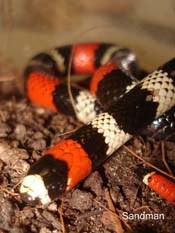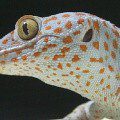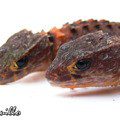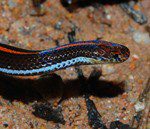
Glandular snake
(Maticora intestinalis) is a member of the Aspid family. Its range extends to the territories of the Philippine and Sunda Islands. It inhabits Thailand, Burma, the Malay Peninsula. Prefers to settle in moderately humid areas, abundantly overgrown with trees and shrubs. This species is quite small in size – about half a meter in length. She has a bright color – a red stripe runs along the back and is limited by black stripes. On the sides are yellow stripes, bordered in black. The main diet of the glandular snake is dwarf snakes. Its poison is neurotoxic and very strong, however, it bites quite rarely, preferring to evade pursuit or scare with a deceptive maneuver instead of an attack. In the skeleton of this snake there are no vestiges of the pelvis and hind limbs. The left lung is also missing. The glandular snake, like most members of its family, is oviparous. In captivity, keeping is practically impossible, the snake refuses to take water and food, and dies quickly enough.
Contents
Food.
The glandular snake hunts for snakes of other species, mainly for pygmy snakes (kalamaria).
Keeping.
In captivity, feeding this species is almost impossible. She refuses to take water and food, and, unfortunately, soon dies.
Description.
The common glandular snake is the most common member of the aspid family. The snake is quite small in size. In length, it reaches about half a meter, of which a third of the length falls on the tail. This snake has six upper labials. A single shield is located in front, two temporal shields lying one above the other are located behind. Her color is bright – a red stripe runs along the entire back, with a black border. The underside is completely covered with black and yellow alternating wide half rings. The anal shield is also painted in black. The tail is painted bright red underneath. Its underside is yellow. It can be either with transverse stripes or without them. The dorsal strip divides into two branches near the posterior edge of the parietal shield, which, in turn, stretch towards the nostrils. The underside is covered with wide black and yellow alternating half rings. The underside of the tail is yellow, it may also have transverse stripes. Black anal shield.
In specimens from the island of Java, on a red-brown background, they have a dorsal stripe of red color, with a black border. They also have yellow side stripes on each side, also framed by a black border.
The glandular snake is thought to be a diurnal snake, but its vision is most likely in line with its extremely small, rounded pupil, as weak as its hearing. It is possible to get close enough to the snake without provoking any movement that could be defined as frightened.
The venom of this snake species is very strong, it is dominated by neurotoxins, in the front of the shortened maxillary bones there are paired poisonous teeth, which are noticeably larger in size than the rest of the teeth, they are equipped with a venom channel, bent back and fixed motionless, which is a primitive sign. In asps, the venom-conducting canal originated from the groove, which is located on the front surface of the tooth, by gradually closing its edges. Most often, only one of the snake’s poisonous teeth functions, while the second is the so-called “substitute” in case the first one is lost. In addition to the maxilla, the pterygoid, palatine, and dentaries are also equipped with small teeth.
Despite the poison, she rarely bites. In most cases, she tries to evade pursuit or scare off the attacker with deceptive maneuvers. She curls up on the ground and, pressing her head, raises her tail up. Curving it, she lunges towards the enemy, as if with the intention of biting him. If you try to chase an escaping snake, then it will move in a convulsive, extremely wrong way.
With regard to the reaction of a person to the bite of this snake, one case was described in which, after two hours, the person developed dizziness, followed by suffocation.
Iron snakes, like decorated asps, are very similar to each other. Both of them live in approximately the same areas and are very dependent on their prey, and to such an extent that they do not live in places where it is not common, such as in Ceylon.
Classification
Kingdom: Animalia (animals)
Type: Chordata
Class: Reptilia (reptiles)
Order: Squamata (scaly)
Suborder: Serpentes (snakes)
Family: Elipidae (aspididae)
Species: Maticora intestinalis (common glandular snake)
The scientific name of this family originates from the Greek Aspidos – poisonous snake.
General information.
 The family of aspid snakes in the world is represented by about 180 species, which at one time were combined into 41 genera. This family makes up approximately 7% of all existing modern snake species. This family combines snakes with a small head, an elongated body, a valky, moderately pointed body at the end. It is either rounded or appears obtusely triangular in cross-section due to a ridge protruding from the back. The nostrils open at the rounded end of the muzzle on the sides, the bridle shields are always absent, the head is dressed with large shields, the rest of the body scales are quite diverse. Due to their slender physique, large head shield and smooth scales, many representatives of the aspids look like already-shaped snakes, which is why they are sometimes called poisonous snakes.
The family of aspid snakes in the world is represented by about 180 species, which at one time were combined into 41 genera. This family makes up approximately 7% of all existing modern snake species. This family combines snakes with a small head, an elongated body, a valky, moderately pointed body at the end. It is either rounded or appears obtusely triangular in cross-section due to a ridge protruding from the back. The nostrils open at the rounded end of the muzzle on the sides, the bridle shields are always absent, the head is dressed with large shields, the rest of the body scales are quite diverse. Due to their slender physique, large head shield and smooth scales, many representatives of the aspids look like already-shaped snakes, which is why they are sometimes called poisonous snakes.
habitation.
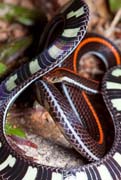 One of the representatives of this family is an ordinary glandular snake that inhabits the territories of the Sunda and Philippine Islands, the Malay Peninsula, Thailand, and is found in Burma. The glandular snake prefers moderately humid spaces overgrown with shrubs and trees. He likes to hide among deadwood, under roots and branches, in rodent burrows and cracks in the soil, in rocky mounds. Most often, a glandular snake can be found lying motionless on the ground. The body will be curved in various ways, but not curled.
One of the representatives of this family is an ordinary glandular snake that inhabits the territories of the Sunda and Philippine Islands, the Malay Peninsula, Thailand, and is found in Burma. The glandular snake prefers moderately humid spaces overgrown with shrubs and trees. He likes to hide among deadwood, under roots and branches, in rodent burrows and cracks in the soil, in rocky mounds. Most often, a glandular snake can be found lying motionless on the ground. The body will be curved in various ways, but not curled.
Breeding.
Due to the fact that the maintenance of this species of snakes in captivity is extremely problematic, information on the reproduction of the glandular snake is extremely scarce. It is known for certain that, like most members of the aspid family, the glandular snake is oviparous. Laying is done before the embryo is fully developed.
Advanced.
One of the most amazing features of glandular snakes is their structure. Rather, the incredibly strong development of the poisonous glands of these snakes. These glands extend far back, penetrate about a third into the body cavity, while pushing the internal organs back. The heart of this snake is shifted almost to the middle of the body.
Unfortunately, the significance of this proliferation of poisonous glands has not yet been precisely determined.
From time to time, the snake loses its poisonous teeth, but not for long – substitute teeth grow in place of the lost ones.
In the skeleton of representatives of the aspid family, there are no rudiments of the hind limbs and pelvis. They also lack the left lung.
All representatives of this family of snakes are poisonous.
The poison of this snake is used in medicine.
Sources.
http://www.floranimal.ru
http://ours-nature.ru
http://dic.academic.ru
http://www.povodok.ru



